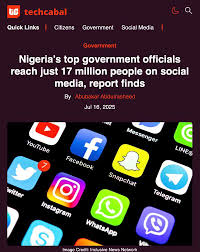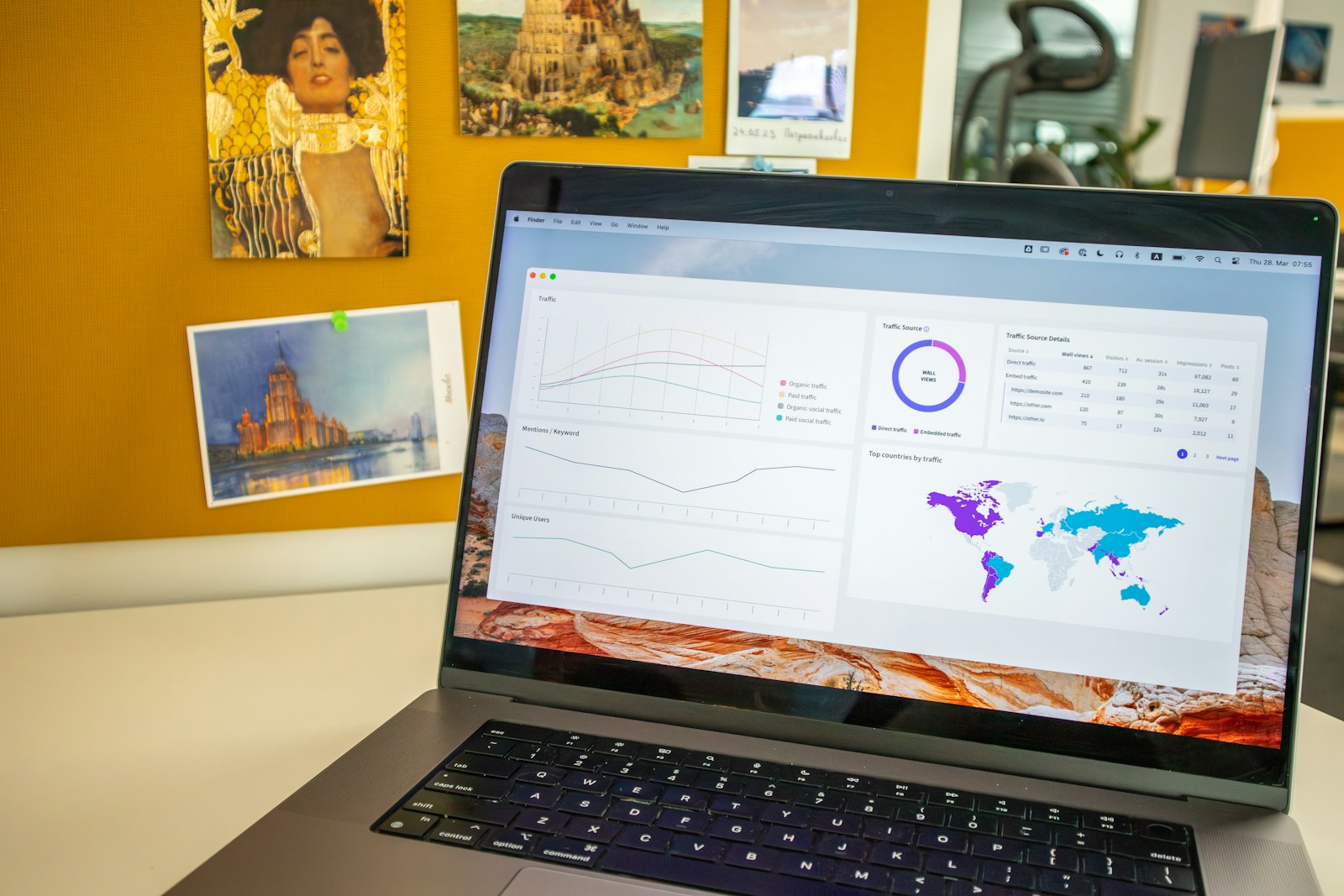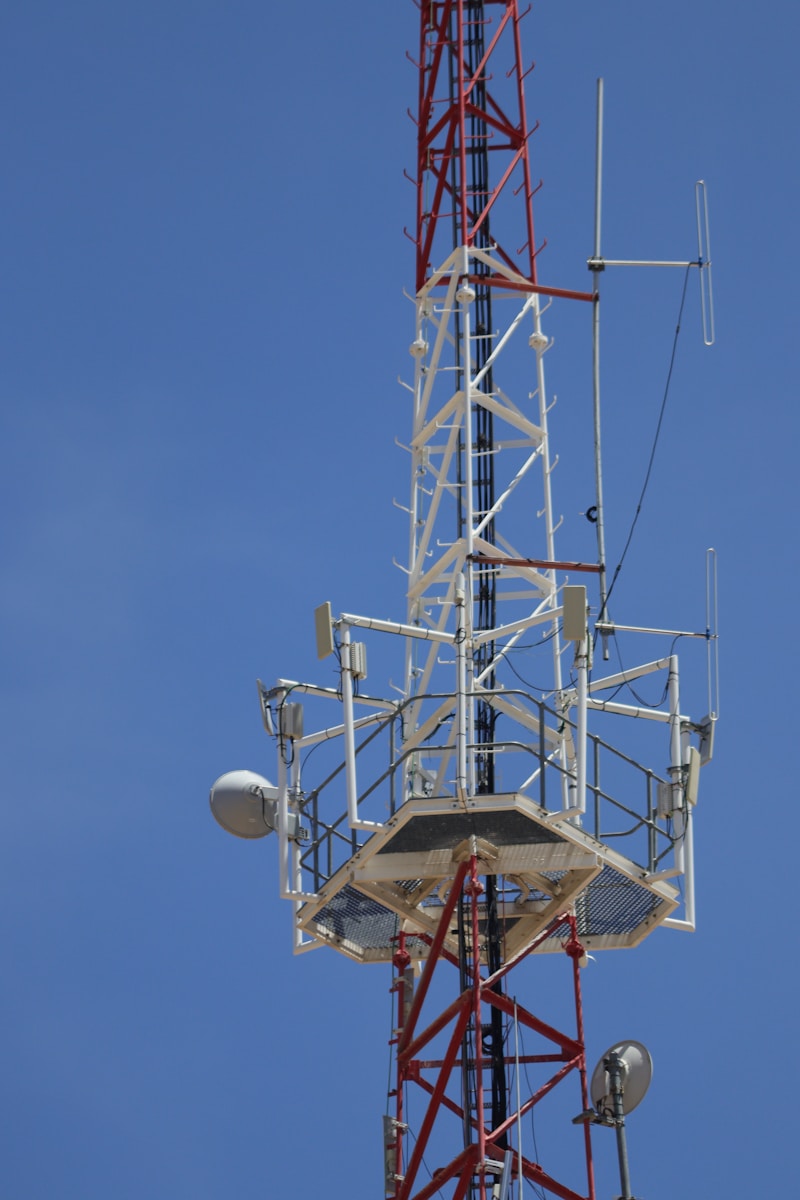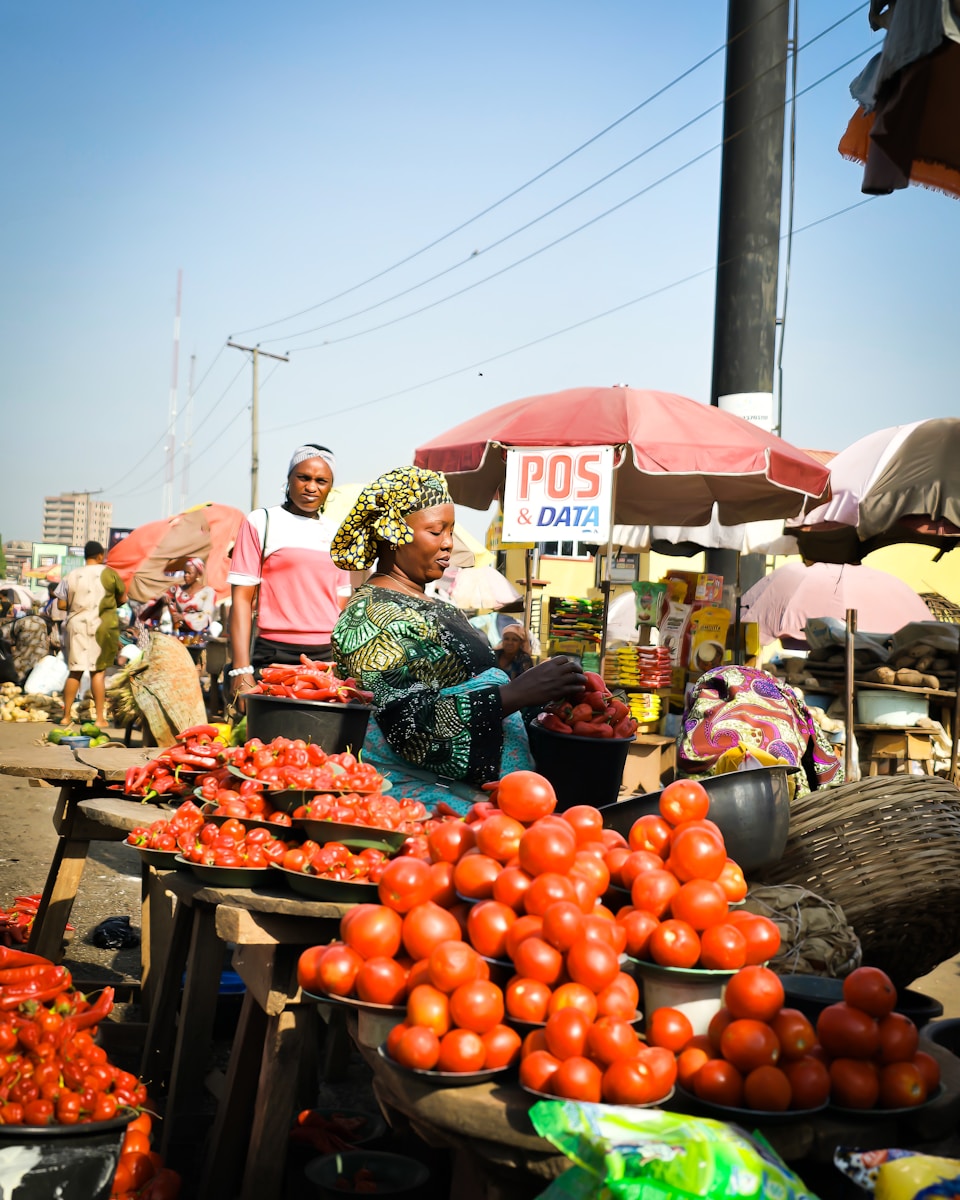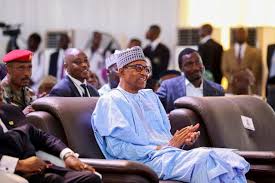
Introduction
Nigeria, Africa’s most populous nation, boasts a staggering 141.5 million internet users—a number that reflects the country’s rapidly growing digital footprint. However, a new report by digital communications firm Column reveals a troubling gap between this digital population and the online presence of the nation’s top leaders. According to the report, the combined social media reach of Nigeria’s president, chief of staff, and key ministers across five major platforms totals just 17 million followers. This stark contrast underscores a widening disconnect between the Nigerian government and its digitally active citizens.
The report highlights an urgent issue: while millions of Nigerians are engaging, organizing, and voicing opinions online, their highest elected officials remain largely absent from these platforms. This absence is not merely a statistical oversight—it represents a missed opportunity for democratic engagement. Social media has evolved into a powerful space for public discourse, where dialogue, criticism, and civic participation unfold in real time. In countries around the world, government officials have increasingly recognized this reality, using digital platforms not only for communication but also as tools for transparency, responsiveness, and public service delivery. In Nigeria, however, this trend has not been fully embraced at the highest levels of leadership.
For more: https://africatrademonitor.com/
The low digital visibility of Nigerian officials is particularly concerning given the country’s youthful demographic. Over 60% of Nigeria’s population is under the age of 25—a generation deeply embedded in the digital world. Platforms like X (formerly Twitter), Facebook, Instagram, TikTok, and YouTube serve as their primary sources of information and venues for civic engagement. When government leaders remain absent or minimally active on these platforms, they miss a critical chance to connect with and listen to the voices of millions of young Nigerians. This lack of engagement also diminishes public trust, reinforces perceptions of government opacity, and fuels the sense that leaders are out of touch with the realities of the population.

Moreover, the report suggests that a stronger digital presence could improve governance by enabling leaders to communicate policies directly, correct misinformation swiftly, and solicit feedback from constituents. A proactive digital strategy could also humanize leaders, making them appear more accessible and accountable. Instead, the current digital silence creates a vacuum often filled by speculation, fake news, and polarizing narratives—further eroding the relationship between the government and the governed.
In an era where digital engagement is not just desirable but essential for effective governance, the Nigerian government’s limited online presence is a strategic shortfall. As citizens increasingly demand transparency, participation, and accountability, it becomes imperative for public officials to meet them where they are—online. Closing this digital gap requires more than just social media accounts; it demands a genuine commitment to consistent, meaningful, and responsive digital communication.
The Column report serves as a wake-up call, urging Nigeria’s political leadership to embrace the digital age not just as a trend, but as a necessary pillar of modern democracy. If harnessed wisely, social media can bridge divides, build trust, and bring governance closer to the people it aims to serve.
Digital Silence or Strategy? Assessing the Nigerian Cabinet’s Social Media Footprint
In the digital age, where information travels at the speed of a click, social media has evolved from a tool of casual communication into an indispensable instrument for political engagement, public diplomacy, and leadership branding. Yet, in Nigeria—a country with one of the largest youth populations and internet user bases in Africa—there is a striking disparity between the digital presence of top government officials and that of their counterparts in the cabinet. A closer look across platforms such as Twitter (now X), Facebook, Instagram, TikTok, and LinkedIn reveals an uneven and highly centralized digital communication strategy within the Nigerian executive arm.
According to recent data, the President, Chief of Staff, and a small group of high-profile ministers dominate the federal cabinet’s digital landscape. In contrast, the majority of ministers maintain either a minimal or entirely non-existent presence online. While some ministers engage only on a single platform, Twitter (X) stands out as the preferred medium, leading in both usage and influence among cabinet members. This trend raises critical questions about the role of social media in Nigerian governance and the broader implications for transparency, public engagement, and the shaping of national narratives.
Twitter (X): The Digital Powerhouse
Twitter (X) remains the undisputed leader when it comes to political engagement within the Nigerian cabinet. Of the ministers who are active on social media, 51 are on Twitter, amassing a combined following of over 9.3 million. This figure represents more than half of the cabinet’s total digital footprint across all major platforms. Twitter’s real-time nature, combined with its influence in media cycles and public discourse, has clearly cemented its status as the go-to channel for political figures aiming to make headlines, set agendas, or engage in public debates.
A major driver of this influence is President Bola Ahmed Tinubu, whose account alone draws 4.5 million followers, representing approximately 26.6% of the cabinet’s entire social media audience. His digital footprint not only underscores the power of personal branding in politics but also highlights the opportunity cost for ministers who remain absent or passive online.
Following Tinubu is Chief of Staff Femi Gbajabiamila, with 1.6 million followers, contributing another 9.5% of the total reach. These two figures, along with Health Minister Muhammad Ali Pate, Aviation Minister Festus Keyamo, and FCT Minister Nyesom Wike, collectively account for over 60% of the cabinet’s digital presence. Their dominance on social media signals both their political relevance and their understanding of the modern communication ecosystem.
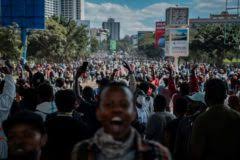
Facebook and Instagram: Still Relevant, Yet Underutilized
Though not as dominant as Twitter, Facebook remains a key platform in Nigeria, especially given its wider demographic reach. Forty-five ministers maintain a presence on Facebook, with a collective following of 4.8 million users. While this number is substantial, it pales in comparison to the potential the platform offers, particularly for reaching grassroots communities, older citizens, and less tech-savvy users who might not be on Twitter or Instagram.
Instagram, often seen as a platform for visuals and lifestyle content, has also made inroads among the ministers, with 46 ministries present and a combined following of 2.1 million. However, the use of Instagram by most cabinet members appears to be passive at best—sporadic posts, lack of engagement with followers, and minimal use of tools like Stories or Reels suggest that many are yet to fully grasp the strategic value of the platform in crafting personal narratives, offering behind-the-scenes glimpses into governance, or humanizing their roles.
TikTok and LinkedIn: The Neglected Frontiers
The most surprising—and arguably most concerning—trend is the cabinet’s near-total disregard for TikTok and LinkedIn. These two platforms hold tremendous potential, particularly for engaging Nigeria’s younger population and professional class.
TikTok, now one of the fastest-growing social platforms globally, is active among only 7 ministers, with a total follower count of just 537,000. Given that Nigeria has a median age of around 18 years and that young people dominate online content creation and consumption, the absence of cabinet representation on TikTok suggests a missed opportunity to engage meaningfully with the country’s largest and most digitally active demographic.
On the other end of the spectrum lies LinkedIn, a platform tailored for professionals, policymakers, and thought leaders. Here, only 17 ministers are present, and they collectively attract just 117,000 followers. For a government that frequently emphasizes reform, policy innovation, and economic transformation, the lack of activity on LinkedIn is puzzling. It suggests a disconnect between the platforms best suited for thought leadership and the current communication strategies of key policymakers.
The Implications: Transparency, Engagement, and Public Trust
The imbalance in the cabinet’s social media presence raises a number of broader implications. First is the issue of public accountability. In a democracy, visibility often translates into transparency. Ministers who fail to maintain a public digital profile deprive citizens of direct communication channels, reducing opportunities for feedback, clarification, or scrutiny.
Second is the question of digital inclusivity. With only a few officials shouldering the burden of online engagement, there is an uneven representation of government activities and priorities. Sectors such as education, agriculture, science and technology, and women’s affairs may remain underrepresented in the public digital discourse, skewing perceptions of what the government is doing or values.
Third is the opportunity cost in terms of national and international influence. A well-maintained social media presence can boost a minister’s credibility not only among local constituents but also in the global arena. Platforms like LinkedIn can amplify Nigeria’s policy direction, economic reforms, and diplomatic posture, especially when key actors actively contribute to thought leadership.
Moving Forward: Building a Cohesive Digital Strategy
In an era where digital engagement is not only expected but required of public officials, the Nigerian cabinet’s fragmented presence across social media platforms reflects a pressing need for coordinated communication reform. While a few high-profile figures such as President Bola Ahmed Tinubu and Chief of Staff Femi Gbajabiamila have successfully cultivated substantial followings on platforms like Twitter (now X), the broader cabinet remains digitally underrepresented and disconnected. This uneven online engagement presents challenges not just for transparency and accountability, but also for fostering trust and inclusion in democratic governance.
To bridge this digital divide, the Nigerian cabinet must adopt a deliberate and cohesive communication strategy that empowers all ministers to effectively engage with citizens, share policy developments, and respond to emerging issues in real-time. A strategic framework should rest on four foundational pillars: capacity building, content diversification, platform-specific strategies, and performance metrics. Each of these components addresses both structural and practical barriers that have so far hindered widespread digital adoption within government leadership.
1. Capacity Building: Equipping Ministers for the Digital Age
Many government officials, particularly those from traditional political backgrounds, may lack the technical expertise or strategic understanding necessary to navigate and leverage digital platforms effectively. Simply having a social media account is not enough. What matters is how that account is used—what kind of content is posted, how consistently, how audiences are engaged, and whether messages align with broader national narratives and policy priorities.
To address this, the government should invest in structured digital communication training programs. These could take the form of hands-on workshops, masterclasses led by communication experts, or one-on-one sessions with digital advisers. Training should cover both technical skills (e.g., using platform analytics, scheduling tools, image editing) and strategic planning (e.g., content calendars, crisis communication, audience segmentation).
Moreover, each minister could be paired with a dedicated digital communication officer whose role is to manage accounts, coordinate messaging across platforms, and ensure content aligns with ministry goals. By institutionalizing digital support within ministries, the burden does not fall entirely on ministers themselves, many of whom juggle immense responsibilities.
2. Content Diversification: Making Governance Relatable and Engaging
One of the major reasons why many ministers struggle to gain traction online is the monotonous nature of their content. Policy updates shared as plain text or formal statements often fail to capture the attention of the average user scrolling through a feed filled with dynamic, visual, and interactive content. To compete in this crowded digital space, content must be diverse, engaging, and emotionally resonant.
Ministers should be encouraged to humanize their digital presence by sharing behind-the-scenes glimpses of their work, highlighting personal stories, or showing community interactions. For instance, instead of simply announcing the commissioning of a new hospital, a minister could post a short video walkthrough, testimonials from beneficiaries, or a before-and-after photo comparison.
Other powerful content formats include:
- Infographics to simplify complex policy data
- Short videos (under 60 seconds) summarizing initiatives
- Live Q&A sessions with citizens to foster two-way dialogue
- Personalized messages on national holidays, crises, or significant events
Content should also reflect the diversity of Nigeria itself—its languages, regions, cultures, and demographics. Multilingual posts, regional spotlights, and culturally relevant references can help ministers connect more meaningfully with varied segments of the population.
3. Platform-Specific Strategies: Maximizing Strengths Across Channels
Each social media platform serves a different audience and lends itself to a different style of communication. A one-size-fits-all approach—where the same content is posted identically on every platform—is not only ineffective, but it also signals a lack of thoughtfulness in digital engagement.
An effective communication strategy requires platform-specific tactics:
- LinkedIn should be used for professional storytelling and policy deep-dives. Here, ministers can publish long-form articles, share thought leadership on reforms, and engage with both Nigerian and international stakeholders in academia, business, and development.
- Instagram, being highly visual, is perfect for human interest stories, ministerial field visits, and celebration of national culture. Instagram Stories and Reels are excellent tools for informal, real-time updates that show ministers in action.
- TikTok offers a golden opportunity to reach Nigerian youth. Ministers can create short, engaging clips to explain policy changes, promote civic education, or respond to trending national concerns in an accessible format. Collaborations with influencers or digital creators could also extend their reach.
- Twitter (X) remains the hub for fast-paced policy announcements, breaking news, and public debates. Ministers should use it for timely updates, live commentary during public events, and interaction with journalists and constituents.
By tailoring content to each platform’s strengths, ministers can amplify their messaging and expand their influence across multiple audience segments, rather than merely broadcasting to the same users in the same way.
4. Performance Metrics: Measuring Success and Driving Improvement
A communication strategy is only as strong as the data that supports it. Without clear performance metrics, it becomes difficult to assess whether a minister’s digital presence is impactful or simply performative. Metrics provide insight into what works, what doesn’t, and where improvements are needed.
Key performance indicators (KPIs) should include:
- Engagement rates (likes, shares, comments, replies)
- Follower growth over time
- Reach and impressions per post
- Click-throughs to policy documents or websites
- Sentiment analysis (positive vs. negative mentions)
These metrics should be monitored regularly using platform-native tools (like Twitter Analytics or Meta Insights) or third-party platforms. Each ministry could publish a quarterly digital engagement report, fostering transparency and creating a culture of accountability.
Additionally, qualitative data such as citizen feedback, media mentions, or civil society reactions can complement the numbers to form a more holistic understanding of impact.
In a world increasingly defined by digital interaction, political relevance is no longer measured solely by appearances on television or the pages of national newspapers. It is now equally—if not more—measured by one’s presence and influence in the digital space. While a few Nigerian cabinet members are harnessing this power effectively, the overwhelming majority remain silent in a space that demands consistent engagement. The time has come for the entire cabinet to view social media not as a distraction or risk, but as a critical tool for leadership, connection, and 21st-century governance.
In stark contrast, some ministers overseeing critical portfolios have almost no digital presence; two have zero followers, and several others attract fewer than 500 followers. The imbalance reflects rising concerns about the inclusivity and reach of government communication to the citizens.
The report noted that for a government steering digital transformation through policies like the Nigeria Digital Economy Strategy (2020–2030), digital platform gaps are more than a missed opportunity; they reflect an internal misalignment between intention and execution.
Ministries are also missing online
The report also reveals the social media presence of the Nigerian ministries. It found that few of the ministries are carving out meaningful online identities, many others, especially those with highly relevant mandates, are trailing. It stated that ministries like Youth Development, Education, Women’s Affairs, and even Information lack strong digital visibility, despite their audience being among the most digitally engaged in the country.
It noted that the absence of these ministries online for engagement contributes to the country’s struggles with youth unemployment, public distrust in institutions, and limited access to real-time information. It warned that digital silence could further erode confidence in governance.
The report argues that being findable, reachable, and responsive on digital platforms is fundamental to modern leadership, adding that ministers who show up online signal openness over others who appear out of reach.
For example, Health Minister Muhammad Ali Pate’s multi-platform strategy and consistent updates during public health campaigns have earned him 1.46 million followers and a reputation for transparency. In contrast, the ministers of Justice, Finance, and Petroleum Resources, despite managing critical sectors, fall below the median digital reach of 64,600 online audience.
The report stressed that the problem isn’t just presence, it’s infrastructure, stating that many ministers maintain dormant or unverified accounts, with no links on ministry websites or official directories. It flagged 22 ministers with missing links to at least one verifiable social media account, while two are absent from all five platforms.
It noted that unverified accounts were flagged inactive because they created confusion about whether an account is official or even real, and may open up space for misinformation, impersonation, and missed feedback loops. It advised ministries to devise dedicated digital communications strategies across major social media to foster citizen engagement.
Mark your calendars! Moonshot by TechCabal is back in Lagos on October 15–16! Join Africa’s top founders, creatives & tech leaders for 2 days of keynotes, mixers & future-forward ideas. Early bird tickets now 20% off—don’t snooze! moonshot.techcabal.com
External Links
The post by: https://techcabal.com

